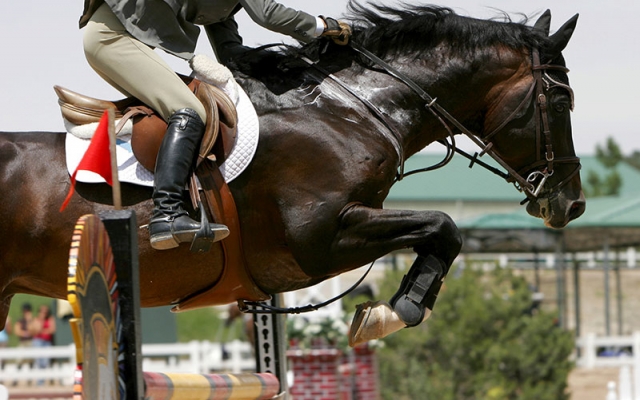
By Dr. Bill Vandergrift, Courtesy of Triple Crown Feed
Many high performance horses present with weak top lines, characterized by little or no fat covering on either side of the spinal processes and poor muscle definition along the spine from the withers back through the coupling and hip.
Performance horses require a strong back to properly balance themselves and power through movements required for racing, galloping, jumping and dressage. A horse with a weak top line is not expected to perform to the best of its ability. The causes of weak top lines are many and often interrelated.
To improve the top line, one needs to determine the primary cause. Often, it is much more involved than simply trying to feed more.
Common factors contributing to a weak top line include:
Gastric ulcers | Intestinal inflammation | Chronic pain
Sore back | Subluxation of vertebrae | Inadequate nutrition
Many performance horses present with gastric ulcers, intestinal inflammation or both. When a horse suffers from gastric ulcers/intestinal inflammation, nutrients are not adequately digested and assimilated. Additionally, metabolic hormones (cortisol, insulin, growth hormone) are adversely affected, resulting in poor utilization of energy and protein substrates.
The net result is the inability to increase muscle protein and effectively metabolize energy sources. A horse in such condition cannot build muscle or lay down fat on their top line, no matter how much is fed. Furthermore, intestinal inflammation often presents concurrent with a sore back and tight hamstrings.
For gastric ulcers, I recommend omeprazole; I recommend EquiVision’s 21-Day Hind Gut Health Program for intestinal inflammation, and for sore back and tight hamstrings, physical therapy, massage and chiropractic adjustment are recommended.
Chronic pain alters metabolic hormone profiles, especially cortisol, which decreases nutrient utilization and increases muscle breakdown. A horse in a chronic state of breaking down muscle will almost always have a weak top line.
Causes of chronic pain include micro fractures, tendon/ligament injuries, osteoarthritis, strained muscles, spinal subluxation(s) and hoof pain caused by navicular syndrome, laminitis or sesamoiditis. A horse suffering from chronic pain will subconsciously adjust its use of muscles in an attempt to relieve pain, resulting in an unbalanced horse with a weak top line.
I recommend an evaluation by a veterinarian or chronic pain expert since the horse may not show any visible signs of lameness, making it extremely difficult to isolate the source of pain.
Subluxation of spinal vertebrae is also common. Spinal vertebrae out of alignment interfere with normal muscle innervations. Muscles that lack adequate innervation cannot function normally, resulting in atrophy. Interruption of normal muscular innervation also affects other organ functions such as the digestive system and immune system.
Physical therapies such as aquatic treadmills, swimming, TheraPlate and massage, combined with proper chiropractic adjustment, can be extremely effective.
Nutrition can also play a significant role in helping horses strengthen a weak top line. For instance, for a horse with gastric ulcers/intestinal inflammation, I recommend Triple Crown’s Alfa-Lox Forage to buffer the digestive system and support cellular regeneration of the digestive tract.
I also recommend, Triple Crown Senior to support healthy fermentation in the large intestine, in combination with omeprazole to heal and prevent gastric ulcers and EquiVision’s 21-Day Hind Gut Health Program to decrease inflammation of digestive tissue, help heal the digestive system and improve fermentation.
For nerve impairment, I recommend vitamin E supplementation (EquiVision’s E/C supplies multiple forms of natural Vitamin E, as well as Vitamin C). In severe cases, I include amino acid supplementation known to improve muscle protein synthesis, such as L-carnitine, L-leucine and beta-alanine.
These amino acids can be found in high concentration in whey protein or supplemental products such as Triple Crown’s Alfa-Lox and EquiVision’s Moving Up.
It is also imperative to provide high quality forage sources to horses exhibiting weak top lines. Four to seven pounds of alfalfa hay or cubes per day can be extremely beneficial to horses in need of extra condition.
Utilizing a feed with 10% fat or more will provide concentrated calories without making the horse too hyper, especially if it is a fiber-based feed such as Triple Crown Senior.
Weak top lines can be a multi-faceted problem. Utilizing a systematic approach to rule out or address each issue, beginning with the most prevalent, can successfully correct this common condition. Your horse’s attitude and performance, as well as your enjoyment, will increase too.
Read more at: www.triplecrownfeed.com.

































